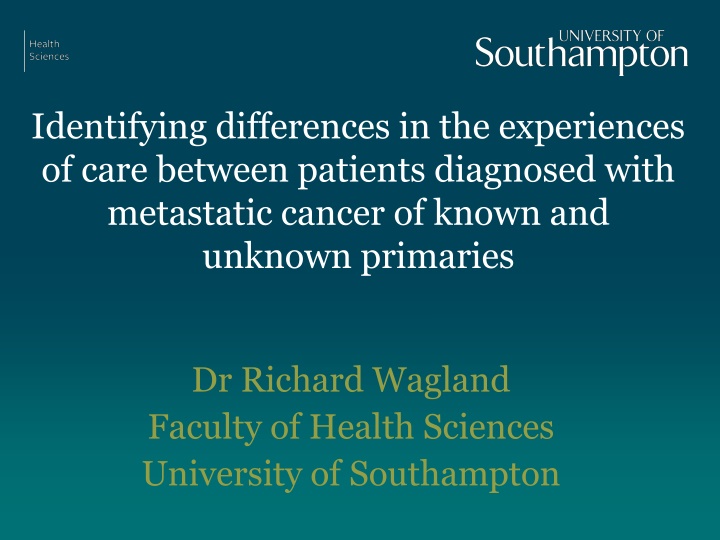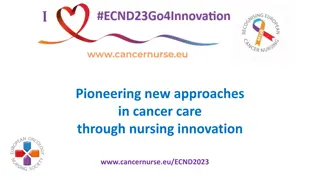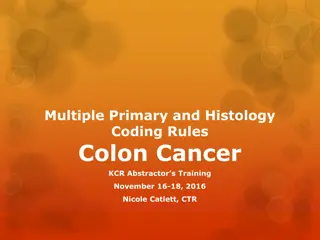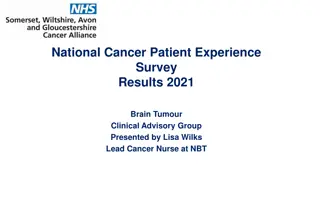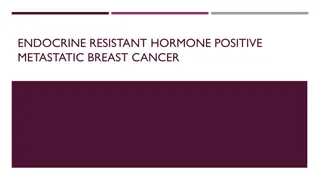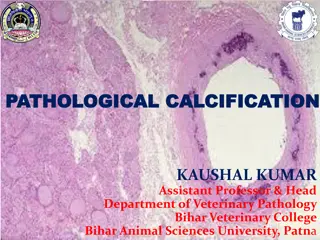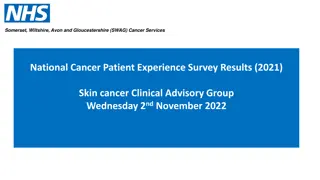Experiences of Care in Metastatic Cancer Patients: Known vs Unknown Primaries
Investigating differences in care experiences between patients with metastatic cancer of known versus unknown primaries, Dr. Richard Wagland from the University of Southampton examines quality of life, psycho-social research, treatment disparities, and sample limitations. The study highlights areas of uncertainty, distress, management challenges, and implications for patient outcomes.
Download Presentation

Please find below an Image/Link to download the presentation.
The content on the website is provided AS IS for your information and personal use only. It may not be sold, licensed, or shared on other websites without obtaining consent from the author.If you encounter any issues during the download, it is possible that the publisher has removed the file from their server.
You are allowed to download the files provided on this website for personal or commercial use, subject to the condition that they are used lawfully. All files are the property of their respective owners.
The content on the website is provided AS IS for your information and personal use only. It may not be sold, licensed, or shared on other websites without obtaining consent from the author.
E N D
Presentation Transcript
Identifying differences in the experiences of care between patients diagnosed with metastatic cancer of known and unknown primaries Dr Richard Wagland Faculty of Health Sciences University of Southampton
Previous QoL/ psycho-social research Lack of understanding of CUP amongst pts High level of uncertainty and distress (anxiety/depression) Greater number of investigations ( chasing the primary ) Problems with care continuity/accountability MDT tennis NICE Guidance (2010) Taxonomy (MUO, pCUP, cCUP) Recommendation for an MDT in each Trust 2
Matched CPES frequency analysis compared CUP vs. non-CUP Methods CPES (2013) data (n=4,535 identified as CUP patients). Samples matched on 5 variables: (sex; age group; admission type; tumour type; time since tx start). CUP patients who began tx in the past year, (n=1496) 2 tests associations: CUP vs non-CUP and each item A small or greater effect was classified as meaningful Cramer s V >0.1 (df=1) or >0.07 (df=2) 3
Matched samples Observation Age Matched pair samples CUP (n=1496) 66.5 (11.7) 67 (59, 75) 20, 98 583 (39.0%) 913 (61%) (n=1496, 100%) 27% 33% 29% 11% Mean (SD) Median (IQR) Range Male Female CUP Breast Head & Neck Lung Pancreatic Prostate Renal GI C77 C78 C79 C80 Non-CUP (n=1496) 66.6 (11.5) 67 (59, 75) 23, 94 583 (39.0%) 913 (61%) - 111 (7.4%) 185 (12.4%) 271 (18.1%) 44 (2.9%) 52 (3.5%) 89 (5.9%) 744 (49.7%) Sex Diagnosis ICD-10 codes 5
Sample limitations Findings suggest experience CUP & non-CUP similar, except for 9 areas Reflects findings from previous research But, CUP sample not rep profile: 12m survival: 62% (sample) vs. 16% (NCRAS) ICD-C80: 11% (sample) vs. 49% (NCRAS) Thus, CUP sample more positive experience than expected 9
Further issues Survey completed several months post-diagnosis/tx ICD-10 codes do not differentiate CUP Taxonomy (MUO, pCUP and cCUP) CPES sample = Trust admin data records: possible errors: Errors in ICD coding of Pts (coded by admin staff) Multiple ICD codes recorded within medical notes Pt status not updated if primary found (multi MDTS) Pt perception of disease/ Dr best-guess impact on CPES responses 10
Conclusion First large scale comparison CUP Vs. non-CUP experience Specific areas for targeted psychoeducational interventions Greater uncertainty re: understanding diagnosis Less prepared for diagnostic investigations But, signif limitations found with CPES CUP sample data Need for prospective, observational cohort studies for more complete understanding of the issues faced by CUP pts. Difficulties re: ethics/ identifying non-frail cCUP pts 11
Acknowledgements Allison Drosdowsky, MacCallum Cancer Institute, Melbourne, Australia Prof. Alison Richardson, University of Southampton, UK Dr John Symons, Cancer of Unknown Primary Foundation Linda Mileshkin, Peter MacCallum Cancer Institute, Melbourne, Australia Dr Mike Bracher, University of Southampton, UK Prof. Penny Schofield, Swinburne University of Technology Melbourne, Australia 12
Reference Boyland L, Davis C. Patients' experiences of carcinoma of unknown primary site: dealing with uncertainty. Palliat Med 2008;22:177 83. Richardson A, Wagland R, Foster R, et al. Uncertainty and anxiety in the cancer of unknown primary patient journey: a multiperspective qualitative study. BMJ Support Palliat Care 2015;5:366 72. Hyphantis T, Papadimitriou I, Petrakis D, et al. Psychiatric manifestations, personality traits and health-related quality of life in cancer of unknown primary site. Psychooncology 2013;22:2009 15. Karapetis CS, Guccione L, Tattersall MH, et al. Perceptions of cancer of unknown primary site: a national survey of Australian medical oncologists. Intern Med J 2017;47:408 14. 13
Table 1 Terms used in NICE guideline to define CUP Malignancy of undefined primary origin (MUO) Metastatic malignancy identified on the basis of a limited number of tests, without an obvious primary site, before comprehensive investigation Provisional carcinoma of unknown primary (provisional CUP) Metastatic identified on the basis of the histology or cytology, with no primary site detected despite a selected initial screen of investigations, before specialist review and possible further specialised investigations epithelial or neuro-endocrine malignancy origin Confirmed unknown (confirmed CUP) carcinoma primary of Metastatic identified on the basis of final histology, with no primary site detected despite a selected initial screen of investigations, specialist review, and further specialised investigations as appropriate epithelial or neuro-endocrine malignancy origin 14
